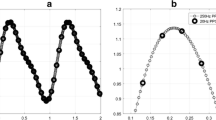Abstract
The suitability of different methods of finding the foot point of a pulse as measured using earlobe photoplethysmography during stationary conditions was investigated. Instantaneous pulse period (PP) values from PPG signals recorded from the ear in healthy volunteer subjects were compared with simultaneous ECG-derived cardiac periods (RR interval). Six methods of deriving pulse period were used, each based on a different method of finding specific landmark points on the PPG waveform. These methods included maximum and minimum value, maximum first and second derivative, ‘intersecting tangents’ and ‘diastole patching’ methods. Selected time domain HRV variables were also calculated from the PPG signals obtained using multiple methods and compared with ECG-derived HRV variables. The correlation between PPG and ECG was greatest for the intersecting tangents method compared to the other methods (RMSE = 5.69 ms, r 2 = 0.997). No significant differences between PP and RR were seen for all PPG methods, however the PRV variables derived using all methods showed significant differences to HRV, attributable to the sensitivity of PRV parameters to pulse transients and artifacts. The results suggest that the intersecting tangents method shows the most promise for extracting accurate pulse rate variability data from PPG datasets. This work has applications in other areas where pulse arrival time is a key measurement including pulse wave velocity assessment.







Similar content being viewed by others
References
Shelley KH. Photoplethysmography: beyond the calculation of arterial oxygen saturation and heart rate. Anesth Analg. 2007;105:S31–6.
Tamura T, Maeda Y, Sekine M, Yoshida M. Wearable photoplethysmographic sensors—past and present. Electronics. 2014;3:282–302.
Acharya UR, Joseph KP, Kannathal M, Lim CM, Suri JS. Heart rate variability: a review. Med Biol Eng Comput. 2006;44:1031–51.
Task force of the European Society of Cardiology and the North American Society of Pacing and Electrophysiology. Heart rate variability: standards of measurement, physiological interpretation and clinical use. Circulation. 1996;93:1043–65.
Weippert M, Kumar M, Kreuzfeld S, Arndt D, Rieger A, Stoll R. Comparison of three mobile devices for measuring R–R intervals and heart rate variability: Polar S810i, Suunto t6 and an ambulatory ECG system. Eur J Appl Physiol. 2010;109:779–86.
Lu S, Zhao H, Ju K, Shin K, Lee M, Shelley KH, Chon KH. Can photoplethysmography variability serve as an alternative approach to obtain heart rate variability information? J Clin Monit Comput. 2008;22:23–9.
Bolanos M, Nazeran H, Haltiwanger E. Comparison of heart rate variability signal features derived from electrocardiography and photoplethysmography in healthy individuals. Conf Proc IEEE Eng Med Biol Soc. 2006;1:4289–94.
Constant I, Laude D, Murat I, Elghozi J. Pulse rate variability is not a surrogate for heart rate variability. Clin Sci. 1999;97:391–7.
Gil E, Orini M, Bailón R, Vergara JM, Mainardi L, Laguna P. Photoplethysmography pulse rate variability as a surrogate measurement of heart rate variability during non-stationary conditions. Physiol Meas. 2010;31:1271–90.
Khandoker AH, Karmakar CK, Palaniswami M. Comparison of pulse rate variability with heart rate variability during obstructive sleep apnea. Med Eng Phys. 2011;33:204–9.
Lu G, Yang F, Taylor JA, Stein JF. A comparison of photoplethysmography and ECG recording to analyse heart rate variability in healthy subjects. J Med Eng Technol. 2009;33:634–41.
Selvaraj N, Jaryal A, Santhosh J, Deepak K, Anand S. Assessment of heart rate variability derived from finger-tip photoplethysmography as compared to electrocardiography. J Med Eng Technol. 2008;32:479–84.
Wong J, Lu W, Wu K, Liu M, Chen G, Kuo C. A comparative study of pulse rate variability and heart rate variability in healthy subjects. J Clin Monit Comput. 2012;26:107–14.
Chui YC, Arand PW, Shroff SG, Feldman T, Carroll JD. Determination of pulse wave velocities with computerized algorithms. Am Heart J. 1991;121:1460–70.
Kazanavicius E, Gircys R, Vrubliauskas A. Mathematical methods for determining the foot point of the arterial pulse wave and evaluation of proposed methods. Inf Technol Control. 2005;34:29–36.
Millasseau SC, Stewart AD, Patel SJ, Redwood SR, Chowienczyk PJ. Evaluation of carotid-femoral pulse wave velocity: influence of timing algorithm and heart rate. Hypertension. 2005;45:222–6.
Phillips JP, Kyriacou PA. Comparison of methods for determining pulse arrival time from Doppler and photoplethysmography signals. Conf Proc IEEE Eng Med Biol Soc. 2014;1:3809–12.
Vardoulis O, Papaioannou TG, Stergiopulos N. Validation of a novel and existing algorithms for the estimation of pulse transit time: advancing the accuracy in pulse wave velocity measurement. Am J Physiol Heart Circ Physiol. 2013;304:H1558–67.
Nichols W, O’Rourke M, Vlachopoulos C. McDonald’s blood flow in arteries, sixth edition: theoretical, experimental and clinical principles. Boca Raton: CRC Press; 2011.
Rybynok V, May JM, Budidha K, Kyriacou PA. Design and development of a novel multi-channel photoplethysmographic research system. In: IEEE point-of-care healthcare technologies. 2013.
O’Haver TC, Begley T. Signal-to-noise ratio in higher order derivative spectrometry. Anal Chem. 1981;53:1876–8.
Phillips JP, Kyriacou PA, Jones DP, Shelley KH, Langford RM. Pulse oximetry and photoplethysmographic waveform analysis of the esophagus and bowel. Curr Opin Anesthesiol. 2008;21:779–83.
Conflict of interest
The authors declare that they have no conflict of interest.
Author information
Authors and Affiliations
Corresponding author
Rights and permissions
About this article
Cite this article
Hemon, M.C., Phillips, J.P. Comparison of foot finding methods for deriving instantaneous pulse rates from photoplethysmographic signals. J Clin Monit Comput 30, 157–168 (2016). https://doi.org/10.1007/s10877-015-9695-6
Received:
Accepted:
Published:
Issue Date:
DOI: https://doi.org/10.1007/s10877-015-9695-6




